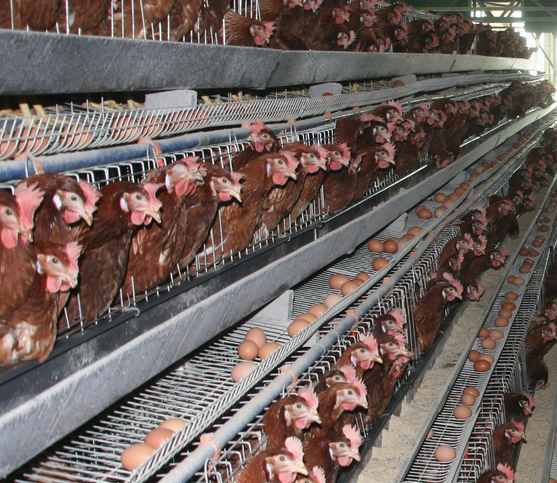In cage system poultry are reared on raised wire netting floor in smaller compartments, called cages, which could be fitted with stands on floor of house or hanged from the roof. It has been shown to be very efficient for laying operations, right from day-old to disposal. Currently, 75% of commercial layers in the world are kept in cages. They consist of rows of stairs-step cages in long narrow shelters. The thatch roof or insulated metal roof shelter can be completely open on the sides with perhaps some canvas curtains in areas where cold winds are experienced. The building should be oriented east and west and designed to provide shade for the cages near the ends.
A 3.4 metre length will allow for four cages without overlap and passageway of about 0.9m. While cleaning is easily achieved on a concrete floor, smooth hard soil is less expensive and quite satisfactory. A little loose sand or other litter spread on the soil before the manure collects will make manure removal easier. The building posts should be treated with wood preservative and well-built enough to support the cages. Rat guard should be installed on the posts at a height of 0.8 to 1m. A central passage, raised 20cm and cast of concrete is easily cleaned and keeps manure from encroaching on the work area. Feeding and egg collecting are easily done by hand or with an automatic system. Ensure that watering trough is carefully adjusted so that all birds receive water. The simplest method of supplying water automatically or by hand at one end is to slope the entire building and row of cages 10mm/3m of length.
Feeders and waterers are attached to cages from outside except nipple waterers, for which pipeline is installed through or above cages. Auto-operated feeding trolleys and egg collection belts can also be used in this rearing system. The droppings are either collected in trays underneath cages or on belts or on the floor or deep pit under cages, depending on type of cages.
Cage types that are equipped with pans to catch the manure are not advocated because they restrict ventilation. Previously used cages should be considered only if they are of suitable design, and have been carefully inspected for condition prior to purchasing.
Cage system needs minimum floor space. It is possible to collect more number of eggs per hen. There is less feed wastage and better feed efficiency. The system provides protection from internal parasites and soil borne illnesses. Sick and unproductive birds can be easily identified and isolated. Clean eggs production. Vices of egg eating, pecking among others is minimal. Broodiness is also minimal. No need of litter material. Artificial Insemination (AI) can be adopted.
The system incurs high initial investment cost. Also handling of manure may be problem. Flies become a greater nuisance. The incidence of blood spots in egg is high. The poultry develop problem of cage layer fatigue. (Laying birds in cages develop lameness. It may be due to Ca and P deficiency but the exact reason is unknown).
Did you love the story? You can also share YOUR story and get it published on Bizna Click here to get started.




